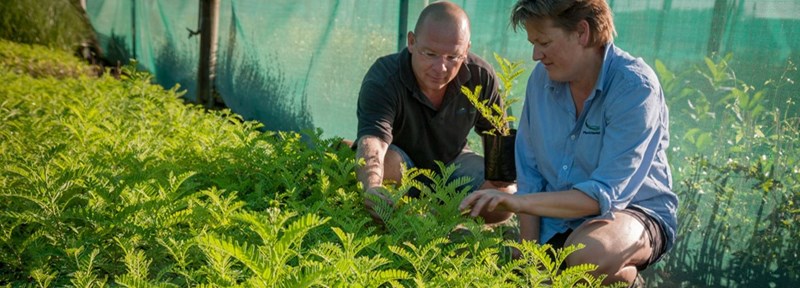
Saving Kakabeak one seed at a time
What started eight years ago as a random discovery of an extremely rare, native kakabeak plant in Hawke’s Bay has become an ongoing joint effort to save the species.
Andy Fleming, Harvest Planning Manager at Rayonier Matariki Forests, says after the initial find by the company’s contractors back in 2012, DNA testing was undertaken to confirm the Clianthus maximus species and any variances from other kakabeak in the area.
Since then Rayonier Matariki Forests has been working with the Forest Life Force Restoration Trust and Department of Conservation to turn around the demise of one of New Zealand’s most endangered plants.
“Our staff have been collecting seeds from the kakabeak plants in our Willowflat Forest and these are being propagated at native tree nursery, Plant Hawkes Bay. We need to amass sufficient supplies of seeds and seedlings so kakabeak can be reintroduced to the area,” says Andy.
The kakabeak is particularly relevant to the Hawke’s Bay as it once grew in abundance and currently occurs naturally only from northern Hawke’s Bay to East Cape, with a few plants historically found in the Bay of Plenty region.
“Unfortunately, one of the major factors contributing to the decline of the kakabeak is its appeal to a wide range of pests including snails, slugs, rabbits, deer, pigs and goats that will often browse the plant to the point of killing it. Because of this, kakabeak is often found on cliff faces where it is out of reach of pests,” says Andy.
Even with safeguards in place, goats have still managed to break into the protected enclosures to feed on kakabeak. When this has occurred it can put the programme back a year or two but the goal remains to see kakabeak flourishing in the Hawkes Bay and possibly in other parts of the North Island too.
Pete Shaw from Forest Life Force Restoration Trust said it is an ongoing challenge to grow and protect kakabeak in the wild but given the critically endangered status of the plant there is a strong focus on succeeding.
“We have lost a few plants to the dry weather and to floods but browsers are an ongoing problem. An annual ‘shoot’ of kakabeak seeds is undertaken by the Department of Conservation, where seeds are balled into dirt and fired en masse into suitable areas. But we need to find more sites that are browser free to ensure the success of this approach,” said Mr Shaw.
The kakabeak is often mistaken for a kowhai when not in bloom, and it is not until the yearly display of distinctive bright red flowers that it can often only then be definitively identified as kakabeak. It is estimated there are only around 100 known Clianthus maximus plants occurring in the wild.
Rayonier Matariki Forests is committed to preserving endangered and threatened species of flora and fauna, Fleming explains, and actively implements protection programmes in its forests.
